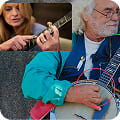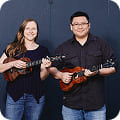Martin Taylor Guitar Academy
Preview this school
Master the Guitar with Martin
Each lesson builds on the last, taking you from zero to hero!
Martin Taylor is a Grammy nominated fingerstyle guitarist, solo jazz guitar virtuoso and online guitar teacher. Pat Metheny says Martin Taylor is "one of the most awesome solo guitar players in the history of the instrument" while Jeff Beck thinks Taylor "out-shreds all of us put together... I’ve never seen anything like it". As one of the world's leading fingerstyle guitarists, Taylor now helps people in over 58 countries become better guitarists of their own. Martin has collaborated with the biggest names in guitar music including Tommy Emmanuel, Jeff Beck, Chet Atkins, Frank Vignola, Barney Kessel, Earl Klugh, Herb Ellis, Scotty Moore, Julian Lage, Andreas Oberg, Albert Lee, Ulf Wakenius, Tony McManus, Martin Simpson and Laurence Juber. Martin has been awarded two honorary doctorates, a BBC lifetime achievement award, an IAJE Jazz Educators award, Top 10 albums in both the USA and UK, a record 14 British Jazz Awards and in 2002 he was appointed MBE 'For Services to Jazz Music' by the Queen of Great Britain. He has been teaching fingerstyle guitar online with ArtistWorks since 2010.
Accompanying a Singer
Introduction To Fingerstyle Guitar
These "introduction" lessons set the stage for what is to follow. Put down your guitar, and enjoy learning about Martin's background, influences, and philosophy about music and the guitar.
Underlying Concepts
The "Underlying Concepts" block starts very basic and progressively lays down the foundation for Martin's approach to fingerstyle guitar. Even if you are already an advanced guitarist, Martin asks that you go through all of these lessons. This block ends with Martin teaching two versions of the jazz classic "Satin Doll."
Equipment
Developing Technique & Musicianship
Here we switch almost entirely to music, musicianship, and advanced techniques for making music on the guitar.
Learn By Playing Tunes
Watch, listen, play. It's all here: A progressive collection of tunes that represent every skill and technique Martin employs in his fingerstyle guitar playing.
Guided Arrangements
30 Day Challenge
Get Personal Feedback with Video Exchange
Get custom video lessons from your instructor by sending a video of your playing.
How It Works?

1. Submit Your Video
Record and upload directly through our platform. No technical skills required.

2. Get Expert Feedback
Receive personal video responses from Martin Taylor with tips to improve!

3. Learn from Community
Browse exchanges from other students to learn from their questions.
About Martin Taylor Guitar Academy
Martin Taylor is a Grammy nominated fingerstyle guitarist, solo jazz guitar virtuoso and online guitar teacher. Pat Metheny says Martin Taylor is "one of the most awesome solo guitar players in the history of the instrument" while Jeff Beck thinks Taylor "out-shreds all of us put together... I’ve never seen anything like it". As one of the world's leading fingerstyle guitarists, Taylor now helps people in over 58 countries become better guitarists of their own. Martin has collaborated with the biggest names in guitar music including Tommy Emmanuel, Jeff Beck, Chet Atkins, Frank Vignola, Barney Kessel, Earl Klugh, Herb Ellis, Scotty Moore, Julian Lage, Andreas Oberg, Albert Lee, Ulf Wakenius, Tony McManus, Martin Simpson and Laurence Juber. Martin has been awarded two honorary doctorates, a BBC lifetime achievement award, an IAJE Jazz Educators award, Top 10 albums in both the USA and UK, a record 14 British Jazz Awards and in 2002 he was appointed MBE 'For Services to Jazz Music' by the Queen of Great Britain. He has been teaching fingerstyle guitar online with ArtistWorks since 2010.
About Martin Taylor
Martin Taylor is a Grammy nominated fingerstyle guitarist, solo jazz guitar virtuoso and online guitar teacher. Pat Metheny says Martin Taylor is "one of the most awesome solo guitar players in the history of the instrument" while Jeff Beck thinks Taylor "out-shreds all of us put together... I’ve never seen anything like it". As one of the world's leading fingerstyle guitarists, Taylor now helps people in over 58 countries become better guitarists of their own. Martin has collaborated with the biggest names in guitar music including Tommy Emmanuel, Jeff Beck, Chet Atkins, Frank Vignola, Barney Kessel, Earl Klugh, Herb Ellis, Scotty Moore, Julian Lage, Andreas Oberg, Albert Lee, Ulf Wakenius, Tony McManus, Martin Simpson and Laurence Juber. Martin has been awarded two honorary doctorates, a BBC lifetime achievement award, an IAJE Jazz Educators award, Top 10 albums in both the USA and UK, a record 14 British Jazz Awards and in 2002 he was appointed MBE 'For Services to Jazz Music' by the Queen of Great Britain. He has been teaching fingerstyle guitar online with ArtistWorks since 2010.
What students are saying!
Good course, but not for absolute beginners
This was a fine course, and I (an experienced guitarist) got a lot from it, even in 1 month. However, I got it mainly for my daughter, who knows no guitar, but who chose this one b...
But I hate not getting
But I hate not getting a annual rate of 50 % off. I hate by the month
Not real easy to follow.
Not real easy to follow.
There is a lot to learn
I've been a student with Martin Taylor at ArtistWorks since 2012, on and off. Sometime I quit being a member for a couple of years, but Martin's lessons are always pulling me back ...
Highy Recommened for Beginners and Expeirenced Guitarists
My Son purchased my subscription of Martin Taylor’s “Fingerstyle Jazz” course for Father’s Day last year. I admired Martin’s solo work for quite a while but wasn’t sure his course ...
Learn from the master
Great!!
Learning lots
I’ve played guitar for many years, but Martin’s lessons are opening up more understanding of the neck, harmony, and musicianship. Only one month in and I like it a lot.
Study with the Master
This course allows budding solo jazz guitarists and opportunity to work with Martin Taylor, a true master of the idiom. There are numerous videos with PDF scores, and Martin walks ...
Wonderful Course
It will take a very long time to complete the entire course as there’s lots of things to learn from the master. And to have the privilege to ask any question and connect with Marti...
State of art!
AMAZING COURSE!

